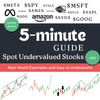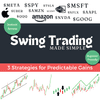
📊 Unlock Powerful Stock Charts!
Get real-time data, custom indicators, and in-depth stock analysis with TradingView.
Try TradingView FreeWhat is P/E Ratio? Explain PE ratio with example
Sun, Jan 19, 2025
Table of Contents
The P/E ratio, or Price-to-Earnings ratio, is a simple way to figure out if a stock's price makes sense compared to how much the company earns. It’s just the stock price divided by the company’s earnings per share (EPS). That’s it.
For example, if a stock costs $50 and the company earns $5 per share, the P/E ratio is 10. It means you’re paying $10 for every $1 the company makes. Pretty straightforward, right?
If you're new to investing, you might also enjoy this guide on how to invest $1,000 on Robinhood to get started.
What Does the P/E Ratio Mean in Layman’s Terms?
Think of it like this: you’re buying a machine that makes $1 a day. How much would you pay for it? The P/E ratio tells you exactly that for a company.
If the P/E is 10, you’re paying $10 for each $1 the company earns. A higher P/E means you’re paying more for each dollar earned, which usually means people expect the company to grow in the future.
For tracking your portfolio and understanding metrics like P/E ratio better, consider using Personal Capital, a free tool that makes managing your finances a breeze.
How Do You Calculate the P/E Ratio?
Here’s how I’ve been looking at real numbers recently:
- Apple ($AAPL): Stock price $229.98, EPS $6.08. P/E = 37.83.
- Microsoft ($MSFT): Stock price $429.03, EPS $11.75. P/E = 36.52.
- Tesla ($TSLA): Stock price $426.50, EPS $3.53. P/E = 121.
- Ford ($F): Stock price $10.18, EPS $0.81. P/E = 12.5.
- NVIDIA ($NVDA): Stock price $137.71, EPS $2.57. P/E = 53.51.
Each one tells you something different. Apple and Microsoft have similar P/E ratios, which makes sense—they’re both big, steady tech companies. Tesla’s P/E is way higher, reflecting its big growth expectations. Ford’s P/E is much lower, which might mean it’s undervalued or just not as exciting to investors.
Speaking of growth stocks, you might find this analysis of MercadoLibre interesting as it dives into a top performer in emerging markets.
What Is a Good P/E Ratio?
What counts as a “good” P/E ratio depends on a few things, like the industry and the company itself.
- A low P/E (under 15) could mean the stock is undervalued or in a slow-growing industry.
- A moderate P/E (15–25) often suggests a balance between price and growth.
- A high P/E (above 25) means the market expects growth—or maybe the stock’s just overhyped.
If you're exploring whether high-growth companies are worth their valuations, check out this post about SentinelOne, a potential leader in cybersecurity.
Is 40 P/E Good?
A P/E of 40 isn’t automatically good or bad. It depends on what’s driving that number. If the company is growing quickly, 40 might make sense. If growth is slow, it could mean the stock is overpriced.
Take Tesla with its P/E of 121. Investors are betting big on its future growth. Compare that to Ford with a P/E of 12.5—much lower, but Ford’s growth expectations are also much lower.
So, is 40 good? Depends on the story behind the number.
How Do You Interpret P/E Ratio?
I like to think of the P/E ratio as a quick way to check how the market feels about a company.
A high P/E usually means people are optimistic about the future and willing to pay more for the stock. A low P/E might mean it’s undervalued—or it could mean investors don’t see much growth ahead.
Look at these examples:
- Apple ($AAPL): P/E of 37.83. Investors are paying $37.83 for every $1 Apple earns.
- Microsoft ($MSFT): P/E of 36.52. Similar to Apple, reflecting steady growth.
- Tesla ($TSLA): P/E of 121. High, tied to big growth expectations.
- Ford ($F): P/E of 12.5. Low, reflecting slower growth.
The key is comparing the P/E to similar companies and figuring out why it’s high or low. If you're considering growth potential in other sectors, this blog on EOG Resources is worth a look.
When Should You Use the P/E Ratio?
For me, the P/E ratio is like a starting point. It gives me a quick sense of whether a stock is priced reasonably for what it’s earning.
Here’s what I ask myself:
- Why is the P/E high or low?
- Is this stock priced for growth, or is it undervalued for a reason?
- How does the P/E compare to similar companies in the same industry?
It’s not the whole story, but it gets me asking the right questions. If you're curious about other tools to evaluate stocks, check out TradingView for advanced charting and analysis.
What Are the Limitations of the P/E Ratio?
The P/E ratio isn’t perfect. It doesn’t work for companies with negative earnings—there’s no way to calculate it. And it doesn’t consider debt, growth rates, or industry trends.
It’s just one metric. You need to look at other things like the company’s financials, its competition, and the overall market conditions to get the full picture.
Final Thoughts: Is the P/E Ratio Enough?
The P/E ratio is simple, but it’s not a magic answer. It’s more like a clue. When I see a P/E, I use it to dig deeper. Why is it high? Why is it low? Does it make sense for this company and this industry?
If you’re comparing stocks, the P/E ratio is a great place to start. Just don’t stop there. Pair it with other research to make smarter decisions.
Not financial advice, just sharing my thoughts!
Related Posts
Oscar Health (OSCR) Is Just Starting To Explode — Here’s Why I’m Buying
Thu, Jun 19, 2025
Oscar Health (OSCR) is gaining momentum with strong growth and undervalued metrics—here’s why I’m opening a position despite the risks.
Free Cash Flow Margin (FCF Margin) - Revenue Lies. Profit Misleads. This Tells the Truth.
Tue, Jun 10, 2025
Learn how free cash flow margin reveals a company’s real cash health beyond profit and why it matters for smarter investing decisions.
Free Cash Flow - This One Number Reveals What a Company Really Makes
Fri, Jun 6, 2025
Learn what free cash flow really means, how to calculate it, and why it matters more than revenue in stock analysis.
🌟 Buy Me Coffee
Love the market insights, stock analyses, and investing tips I share? Help me do more by buying me coffee. Your support funds deeper research, keeps content ad-free, and helps create more tools and resources for the community.


